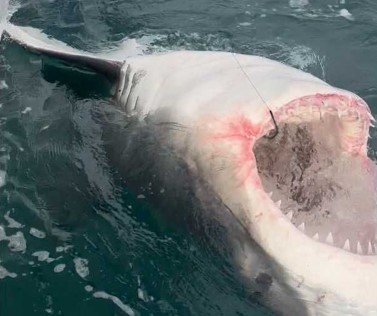
Massive shark tagged by Cape Cod researcher makes shark science history: ‘A dream come true’
The nearly 3,000-pound monstrous great white shark tagged by a Cape Cod researcher has really be on the move.
White shark “LeeBeth” has traveled more than 2,000 miles since she was tagged in December — and has now made shark science history.
LeeBeth recently pinged off the coast of Matamoros, Mexico; this is the furthest west a white shark has ever been tracked into the Gulf of Mexico, where many sharks migrate to during the winter months.
“This represents a very historic moment in white shark science,” Atlantic White Shark Conservancy staff scientist Megan Winton said this week, later adding, “It’s huge news from a science perspective.”
Winton was off South Carolina with Outcast Sport Fishing’s Chip Michalove on Dec. 8 for Michalove’s first charter of the season, and they came across the giant shark, which is likely between 25 and 30 years old.
They caught and tagged the estimated 2,800-pound, 14-foot great white female shark off Hilton Head.
“It’s been addicting to watch what this shark is doing,” Michalove said. “I’m picking up my phone every 20 minutes. I’m like a middle schooler looking at the app to try to figure out where’s the next ping going to be.”
“It’s been a dream come true,” he later added.
Related Articles
Off Massachusetts coast, dozens of North Atlantic right whales unexpectedly spotted in shipping lanes
Cape Cod shark researchers share ‘incredible’ video footage from the view of a 3,000-pound great white
Sharks scavenge carcass of North Atlantic right whale with ties to Cape Cod
Shark sightings across New England: Where were the great white shark hotspots last year?
Deadly shark bites have jumped: Where did the most shark bites happen in the US?
Yesterday, white shark LeeBeth made shark science history, pinging in off the coast of Matamoros, Mexico. This is the furthest west a white shark has ever been tracked into the Gulf of Mexico. pic.twitter.com/ApptbskGOb
— Atlantic White Shark Conservancy (@A_WhiteShark) February 29, 2024
On Dec. 8, LeeBeth swam away with the first ever camera tag put on a shark in that southeastern region. The researchers recently shared some “incredible” video footage from the view of the shark.
They were also able to attach a satellite spot tag that people can follow on the Atlantic White Shark Conservancy’s Sharktivity app, and a pop-up satellite archival tag that will detach in 8 months.
The long distance movements of LeeBeth highlight why international coordination is critical for white shark conservation, Winton said.
“It’s always interesting when you got a species being documented in an area where we knew they probably occurred, but we had no proof of,” Winton added. “So again, from a conservation perspective, this is really important information. It also points us in the direction of other areas where it might be worth looking for this species, monitoring this species, looking at areas that are important to protect from a habitat perspective as well.”
White shark LeeBeth has made shark science history, pinging in off the coast of Matamoros, Mexico. (Atlantic White Shark Conservancy graphic)


